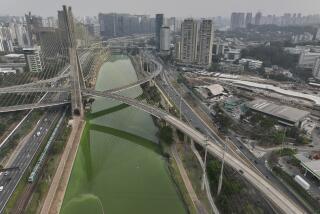Mexico City Calls 1st Smog Alert, Delays It a Day
MEXICO CITY — Mexico’s environmental authorities Friday declared a smog alert for the first time ever, as heavy layers of pollutants blanketed the city throughout most of the day, irritating eyes and lungs and raising tempers over government inaction.
The alert, however, was not called for Friday, a day of evident heavy pollution, but for today and Sunday--days when auto traffic drops off, factories close and, as a result, smog decreases anyway.
The government warned children and old people not to exercise or go to crowded places and asked citizens to reduce driving and not to burn trash over the weekend. Friday morning, before the government issued the alert, visibility in some parts of Mexico City was down to a few blocks. Residents woke up with stuffy noses, and even inside office buildings, where air is often filtered through air-conditioning systems, workers complained of itchy eyes.
“It’s absurd,” said Homero Aridjis, head of the Group of 100, a prominent environmental organization. “They should have called the alert in the morning. This is an aspirin when what we need is major surgery.”
“Why can’t the government act on what we can see with our own eyes?” asked Armando Chavez, a bootblack on Reforma Boulevard. “We are living with something dangerous.”
The smog warning comes in the wake of heavy criticism of government inaction by environmental groups in the face of growing pollution problems in this city of 17 million, the world’s most populous. Successive announcements of steps to clean up the air over Mexico City have largely gone unfulfilled, the critics say. In January, the government responded by making even more promises.
Although the government has been measuring the air quality for several years and during the past year published results daily, it had never cautioned citizens to slow activities until Friday. Many observers felt that there were plenty of days that could have prompted an alert.
The handling of the smog alert itself seemed to point up official paralysis in the face of growing environmental menace. One official at the Ministry of Urban Development and Ecology said no smog warning was given for Friday because it would have caused chaos at schools and hospitals.
Difficult Political Decision
“Such a warning requires a political decision that is very difficult to make,” said Rene Altamirano, an official at the ministry. “People with children in school would worry.”
Pollution reached dangerous levels in several sections of the city this week, even as measured on the official Mexican scale, which averages out its air quality index over a 24-hour period. According to government figures, air quality was “very poor” in the northeast and southwest neighborhoods Wednesday and Thursday and “poor” everywhere else.
Although the air appeared more soupy than ever Friday, the government said that contamination diminished. Officials at the ecology ministry attributed the improvement to an order to reduce emissions issued Thursday night to about 270 “highly polluting” factories. One-tenth of those stopped operating for the day, resulting in a 30% decrease in smokestack pollution, said ministry official Altamirano.
However, neither Altamirano nor other officials at the ecology ministry would supply The Times with the name of a single factory that had reduced its operations. In any event, by the ministry’s own reckoning, 75% of Mexico City’s pollution is produced by automobile exhaust, not factory emissions.
Environmentalists have likened the Valley of Mexico, where Mexico City is located, to a gas chamber full of harmful chemicals that cause chronic lung problems and, in the long run, shorten lives. Birds have been known to drop dead from the skies over the capital.
The U.S. State Department, in recognition of the health risks, offers extra pay or bonus pension arrangements to Foreign Service employees at the U.S. Embassy here.
The city’s high altitude--7,347 feet above sea level--compounds the problems since, under the best of conditions, there is about 25% less oxygen to breathe than at sea level. In winter, cold air, along with pollutants, are often trapped near the valley floor by warmer air in the upper atmosphere.
More to Read
Sign up for Essential California
The most important California stories and recommendations in your inbox every morning.
You may occasionally receive promotional content from the Los Angeles Times.










